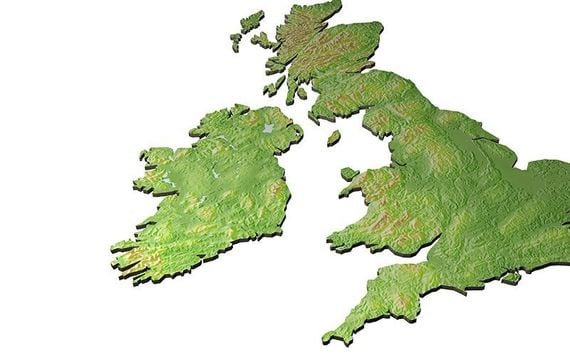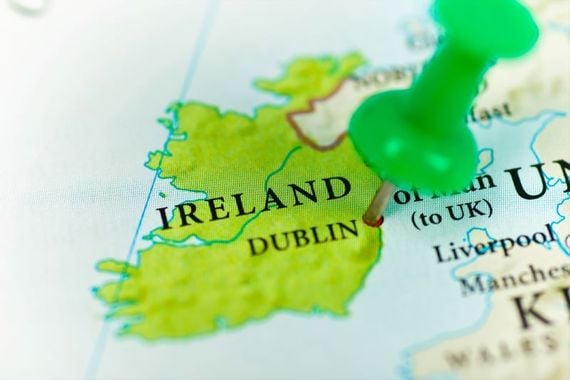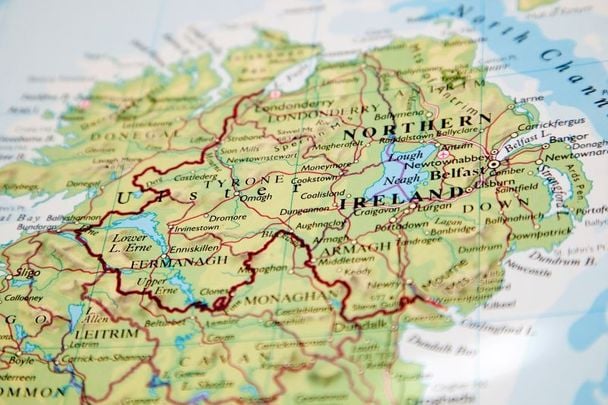Everything you need to know on how the Irish border was created.
In 1922 Sir Austen Chamberlain described the Irish border as “a compromise, and like all compromises is illogical and indefensible.” A century on many Irish people would argue the border remains just that when pressed for their thoughts on the snaking line that cleaves Ireland into two parts.
Countless others would disagree and could tick off the names of relatives wounded or killed in its defense.
For most the line scratched out by bureaucrats in the early 20th century probably doesn’t bother them much; it’s there and that is that.
The idea of an Ireland disjointed and administered out of two capitals was first mooted seriously in the 19th century when Home Rule was advocated by Prime Minister William Gladstone.
Then, as now, rule from Dublin was fiercely resisted by most Protestants in Ulster. “Home Rule means Roman Rule,” cried loyalists amid fears that a legislature in Catholic Dublin would mean discrimination against Protestants.
Where once Presbyterians in Ulster opposed the union with Great Britain now they were its staunchest defenders; not only did they fear Home Rule would ultimately mean independence but they worried that a Dublin Government would be dominated by farmers with little care for the north’s more industrial economy. Ulster, they argued, with its growing manufacturing base and trading links with the world had more in common economically with Britain than the South.

Ireland and the United Kingdom.
While Charles Stewart Parnell refused to “give up a single Irishman” in his quest for a Home Rule Parliament, many of his opponents concluded that the division of the island was the only way to satisfy two so exclusive and yet fiercely held demands.
The Home Rule debate had sowed the seeds of partition and it would not be long before they blossomed.
In 1912 the Liberal Party was in power again and attempted one last role of the dice to settle the Irish Question once and for all.
But the Third Home Rule Bill roused passions that made the opposition to the first two seem mild and dignified.
Irish Party legislators John Dillon and Joseph Devlin intransigently argued that the whole 32 counties of Ireland be placed under the authority of a Dublin Parliament: "No concessions for Ulster, Ulster will have to follow," the pair insisted.
The result was the Ulster Covenant, signed first on September 28, 1912, by Sir Edward Carson with a silver pen and a flourish at Belfast City Hall. In total 471,414 men and women vowed to use “all means which may be found necessary to defeat the present conspiracy to set up a Home Rule Parliament in Ireland. And in the event of such a Parliament being forced upon us, we further solemnly and mutually pledge ourselves to refuse to recognize its authority.”

Love Irish history? Share your favorite stories with other history buffs in the IrishCentral History Facebook group.
Bluffing they were not and in January 1913 Carson moved a motion in the British Parliament that would have exempted all nine Ulster counties from any Home Rule Parliament.
Irish Party leader John Redmond reluctantly responded by suggesting that each county is given a plebiscite allowing it to opt-in or out of Home Rule, all excluded counties would remain governed directly by Westminster.
While Carson had the support of the opposition Conservative party leader Andrew Bonar Law, the governing Liberal Party was inclined to Redmond’s position and suggested that Antrim, Down, Derry and Armagh would be exempted from Home Rule, whilst Cavan, Monaghan, Donegal, Tyrone and Fermanagh would be ruled by Dublin.
Pressing his luck, Redmond suggested the nationalist majority towns Newry and Derry – in the unionist majority counties of Down and Derry – also be given to Dublin; his suggestion was rejected.
Yet still, hardline unionists felt threatened and concluded the only way they could guarantee Home Rule would not be “imposed” was through an armed militia. The formation of the Ulster Volunteers in 1912 lit a similar fuse of militarism in the nationalist community and the result was the Irish Volunteers, who pledged themselves to defending the right of any Home Rule Parliament to govern the country.
Ireland seemed to be marching resolutely towards an orange-on-green civil war and as the events of one fateful day on March 20, 1914, made clear, the almighty British Empire would be powerless to prevent it.
The Curragh Incident, as it came to be called, was the most serious mutiny in Britain’s recent history; with the Home Rule Bill soon to finish its final meandering journey through Parliament, General Sir Arthur Paget informed his officers that action against the Ulster Volunteers might soon be necessary. Any men from the province would be allowed to take a tactical vacation, anyone else not willing to take up arms would be dismissed.
Some 60 officers out of 70 made clear in no uncertain terms that they would rather resign than take up arms against the Ulstermen and that was that. Britain’s authority over the island, having frayed thin for so many years, looked all of a sudden completely impotent. If it could not even use British Army to enforce British law. Did the government in Ireland even exist?
Ultimately, military force against the UVF was averted when in June that year Fermanagh, Tyrone, Armagh, Derry, Down and Antrim were given exemptions from the act.
Unionists on the wrong side of the border reluctantly accepted the terms of the act to avoid civil war and with the tacit admission that “the existence of the Empire was at stake.”
Where once Carson had vociferously argued for the exclusion of Ulster in its entirety, the existence of large Catholic majorities in Cavan, Monaghan, and Donegal meant the inclusion of such counties threatened the long-term vitality of a northern state, with the risk that one day the whole of Ulster would vote to join the southern state. Reluctantly unionists concluded three limbs had to be amputated to save the body.
Thomas Moles, an MP for Titanic's home city of Belfast, morosely pondered, “In a sinking ship, with the lifeboats sufficient for only two-thirds of the ship’s company, were all to condemn themselves to death because all could not be saved?”
This article was originally published in Ireland of the Welcomes magazine. Subscribe now!
The outbreak of the First World War that August saw the Act given Royal Assent but shelved for the duration of the conflict. At a time when the government’s focus had to be squarely on winning the ‘Great War for Civilization,’ there was little time for constitutional innovation.
Fate intervened in the meantime and when Germany surrendered to Britain, Westminster found another conflict had broken out, this time in the United Kingdom’s western appendage. The Irish War of Independence raged for two full years until the two sides agreed on an uneasy truce.
Michael Collins and Arthur Griffith were dispatched to London to thrash out a peace treaty that would lead to Collins’ death and the partition of the island.
The Anglo-Irish Treaty was narrowly ratified by Dáil Éireann, but the provision that Ireland be partitioned was an absolute deal-breaker for many legislators, even if the blow of division was couched in the promise that a Boundary Commission would review exactly where the border should lie.
Collins argued that partition was only temporary and pleaded, “We all known Ulster cannot survive without southern Ireland.”

Map of Ireland.
However, not all legislators thought partition necessarily a bad thing; Cork Deputy John Walsh controversially argued that Sinn Féin’s revolution “was only a partial one… I came to the conclusion that if we included the… West British cutthroats… They would again influence our national policy. The Irish language and all that pertained to it would go by the board… and everything we have fought for through 800 years would be smashed to atoms and swallowed up in the British Empire.”
The outbreak of Civil War following the independence of the Free State in 1922 meant the Commission would not meet until 1924.
Fresh from dividing Upper Silesia following the Treaty of Versailles, a small group of British civil servants cast their eyes west to Ireland. Their boss, Richard Feetham, was a Welsh-born South African and had already produced one report for the British Government on constitutional reform in India.
Joining him was Eoin MacNeill, then the Free State’s Minister for Education, and Joseph Fisher, a liberal unionist representing Northern Ireland. Now safely ensconced in power, Belfast unionists were determined to give “not one inch” to the Free State and refused to appoint someone to a body designed to reduce their territory; irritated, the British Government appointed the maverick Fisher to speak for Ulster.
The Commission soon ran into problems when it became clear that the trio had very different ideas about the purpose of their work; McNeill wanted to see large transfers of nationalist Ulster to the Free State, Feetham hoped to tinker conservatively with the border and Fisher suggested that Belfast should annex Donegal on account of the county’s persistent poverty.
“We ought to bear our share of the burden of congestion and misery, and Ulster can never be complete without Donegal. Donegal belongs to Derry, and Derry to Donegal… and a hostile ‘Afghanistan’ on our northwest frontier would be placed in safekeeping,” he argued.
While this idea had some support among the Commission’s witnesses, ultimately it was a political nonstarter and Fisher was forced to content himself with a two-mile extension of the border into northeast Donegal.

Love Irish history? Share your favorite stories with other history buffs in the IrishCentral History Facebook group.
The outcome that would have most satisfied Dublin, namely the transfer of Catholic areas in Fermanagh, Tyrone, Armagh, Derry and Down was rejected that on the grounds that it “would gratify 258,617 persons and be contrary to the wishes of 205,528 others.” The rate of dissatisfaction was far too high for the Commission to recommend such drastic surgery.
Thus, the tinkering began. East Donegal was for Ulster, but a proposal to give heavily Catholic Strabane in Tyrone was rejected – its hinterland was Protestant. A small sliver of Tyrone was to be gifted to Dublin but that part of the county still under British authority would still retain its Catholic majority.
Fermanagh was treated with similar delicacy. “We may have to go pretty deep in places,” Fisher concluded and 70 square miles were mapped into the southern state; crucially for nervous Protestant farmers, key floodgates would remain in Northern Ireland.
The Commission eyed up north Monaghan where a few heavily Protestant parishes hugged the border but declined to transfer anything; reasoning that the adjacent parishes in Armagh were Catholic. But further to the county’s south, a ten square mile block was scalloped into the north.
Only in Armagh was anything approaching radical change proposed; 14,678 citizens were to be given to Dublin, of whom 13,859 were Catholic.
The fate of Newry was hotly contested; nationalists contended that as three-quarters of its population were Catholics it would shatter the credibility of the Commission were its transferral not proposed. Feetham however inclined to the view that the town was a commercial satellite of Belfast and ruled it would remain in the north.
Overall 282 square miles were to be given to the Free State and 78 to the north; 31,000 people – of whom close to 28,000 of whom were Catholic – would find themselves under Dublin rule and some 8,000 citizens would be given to Belfast – of whom nearly 3,000 were Catholic. The territory of Northern Ireland would drop by 3.7% and the population by 1.8%.
Fisher was at pains to assure Carson that Northern Ireland would, “remain a solid and close-knit unit… somewhat trimmed on the edge… No center of even secondary importance goes over, and with Derry, Strabane, Enniskillen, Newtownbutler, Keady, and Newry in safekeeping, your handiwork will survive. If anybody had suggested twelve months ago that we could have kept so much I would have laughed at him.”
When the proposals were leaked to the media in November they provoked outrage in the south. The humiliation of losing parts of Donegal and Monaghan in return for a minimal gain elsewhere was too much for Dublin and MacNeill tendered his resignation from the Commission.
There was speculation that the Government could lose a motion of no confidence in the Dáil and that Éamon de Valera could be swept to office in a republican backlash.
A meeting between the two remaining commissioners and the Prime Ministers of Britain, Northern Ireland and the Free State was arranged. Joined by Winston Churchill, who was then serving as Chancellor of the Exchequer, the commissioners were told in no uncertain terms that their report was best “burnt or buried”.
Despite their protests that certain anomalies needed to be fixed the rare unanimity between the three governments meant the report was a nonstarter; the six counties would remain united.
H/T: The Irish Border: History, Politics, and Culture
* Originally published in 2017, updated in Oct 2024.




Comments